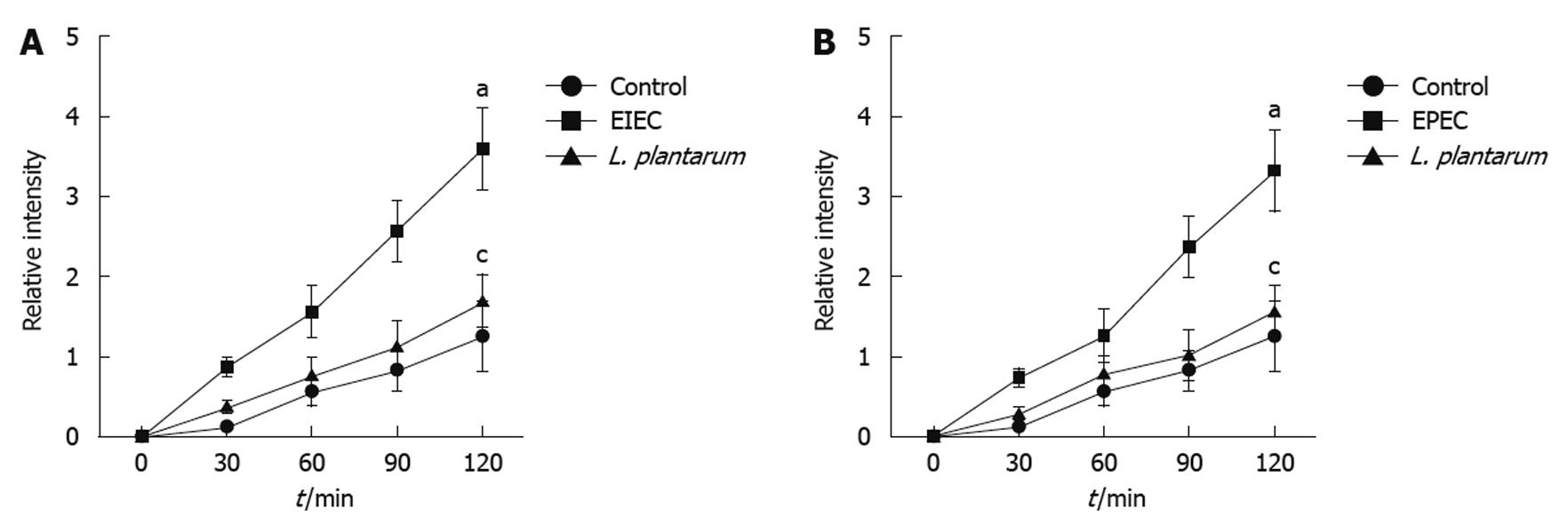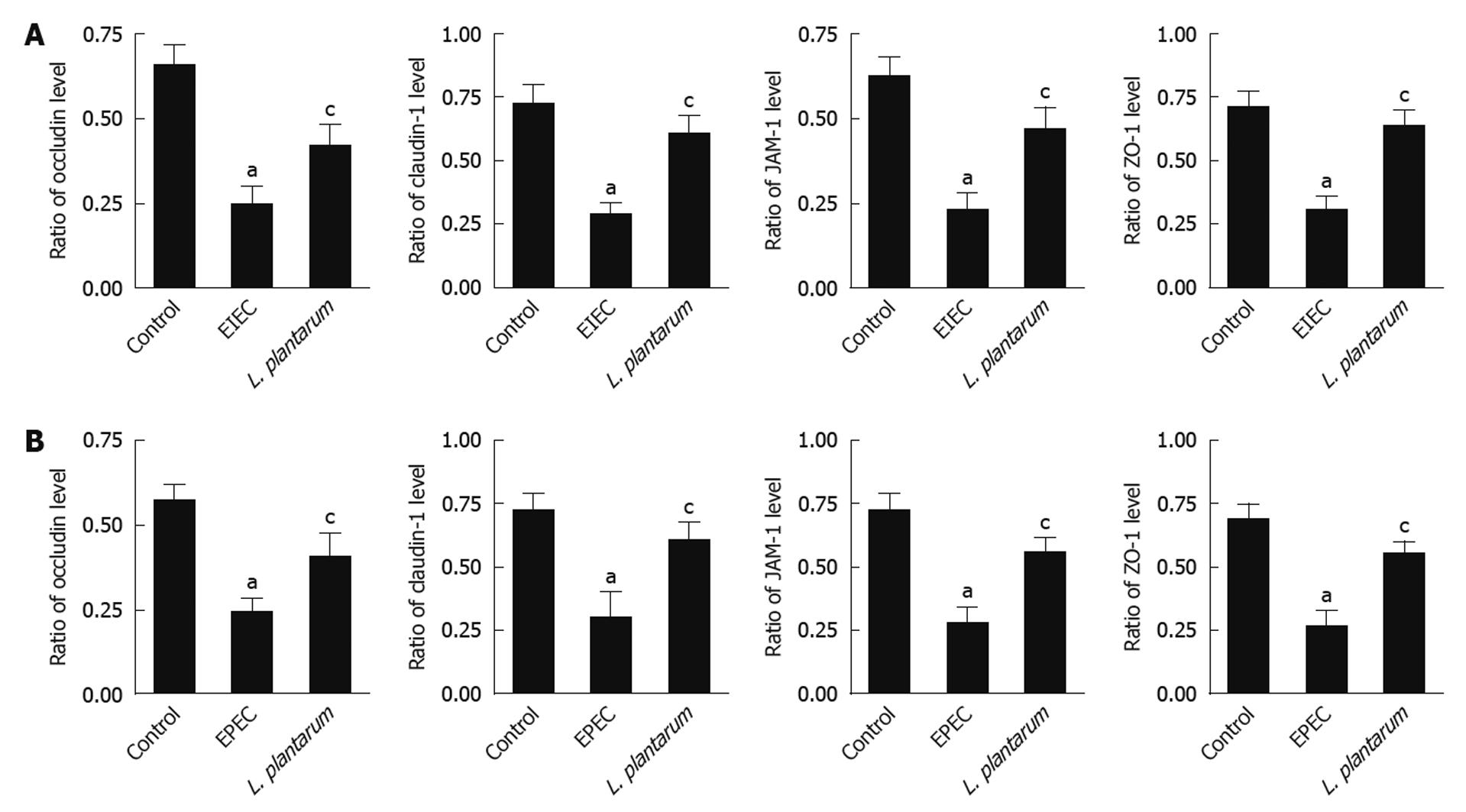Copyright
©2010 Baishideng Publishing Group Co.
World J Gastroenterol. Dec 7, 2010; 16(45): 5759-5765
Published online Dec 7, 2010. doi: 10.3748/wjg.v16.i45.5759
Published online Dec 7, 2010. doi: 10.3748/wjg.v16.i45.5759
Figure 1 Lactobacillus plantarum inhibited the decreased transepithelial electrical resistance through NCM460 cells induced by enteroinvasive Escherichia coli (A) or enteropathogenic Escherichia coli (B).
A: After infection with enteroinvasive Escherichia coli (EIEC) for 24 h, transepithelial electrical resistance (TER) of NCM460 monolayers was decreased significantly compared with the value in the control group. However, TER of EIEC-infected NCM460 monolayers, when simultaneously co-incubated with Lactobacillus plantarum (L. plantarum), was significantly higher than those in the EIEC-infected NCM460 monolayers; B: Similar results were obtained in the experiments with enteropathogenic Escherichia coli (EPEC). The data at each time point represent the mean ± SD obtained from four individual NCM460 monolayers. aP < 0.05 vs control group; cP < 0.05 vs corresponding EIEC or EPEC group.
Figure 2 Lactobacillus plantarum inhibited the increased macromolecular permeability through NCM460 cells induced by enteroinvasive Escherichia coli (A) or enteropathogenic Escherichia coli (B).
A: After infection with enteroinvasive Escherichia coli (EIEC) for 120 min, the relative intensity (RI) was significantly increased in the EIEC group compared with the control group. However, the RI was decreased significantly in Lactobacillus plantarum (L. plantarum) groups compared with the EIEC group; B: Similar results were obtained in the experiments with enteropathogenic Escherichia coli (EPEC). The data at each time point represent the mean ± SD obtained from four individual NCM460 monolayers. aP < 0.05 vs control group; cP < 0.05 vs corresponding EIEC or EPEC group.
Figure 3 Lactobacillus plantarum prevented the decrease in the expression of tight junction proteins in NCM460 cells induced by enteroinvasive Escherichia coli or enteropathogenic Escherichia coli detected by Western blotting.
A: The expression level of tight junction (TJ) proteins was high, including claudin-1, occludin, JAM-1 and ZO-1, in the control group. However, in the enteroinvasive Escherichia coli (EIEC) or enteropathogenic Escherichia coli (EPEC) group, TJ proteins were significantly decreased compared with the control group, which was not observed in the Lactobacillus plantarum (L. plantarum) group; B: Semi-quantitative analysis of Western blotting showed similar results. The data at each time point represent the mean ± SD obtained from four individual NCM460 monolayers. aP < 0.05 vs control group; cP < 0.05 vs corresponding EIEC or EPEC group.
Figure 4 Protective effects of Lactobacillus plantarum and MIMP in mRNA expression of tight junction proteins in NCM460 cells detected by real-time polymerase chain reaction.
A: The mRNA expression of tight junction (TJ) proteins, including occluding, claudin-1, JAM-1 and ZO-1, was decreased in enteroinvasive Escherichia coli (EIEC) group compared with the control group. However, in Lactobacillus plantarum (L. plantarum) group, the mRNA expression levels of the TJ proteins were similar to those in the control group; B: Similar results were obtained with enteropathogenic Escherichia coli (EPEC). The data represent the mean ± SD obtained from three individual NCM460 monolayers. aP < 0.05 vs control group; cP < 0.05 vs corresponding EIEC or EPEC group.
-
Citation: Liu ZH, Shen TY, Zhang P, Ma YL, Moyer MP, Qin HL. Protective effects of
Lactobacillus plantarum against epithelial barrier dysfunction of human colon cell line NCM460. World J Gastroenterol 2010; 16(45): 5759-5765 - URL: https://www.wjgnet.com/1007-9327/full/v16/i45/5759.htm
- DOI: https://dx.doi.org/10.3748/wjg.v16.i45.5759
















